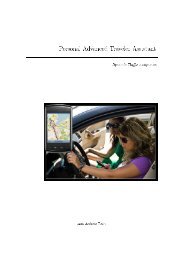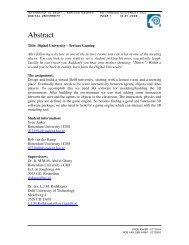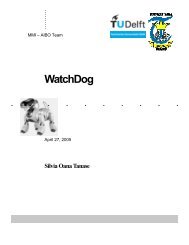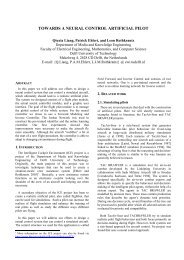Recognition of facial expressions - Knowledge Based Systems ...
Recognition of facial expressions - Knowledge Based Systems ...
Recognition of facial expressions - Knowledge Based Systems ...
Create successful ePaper yourself
Turn your PDF publications into a flip-book with our unique Google optimized e-Paper software.
The term σ<br />
ij<br />
is the covariance between the pixel i and the pixel j. The relation between<br />
the covariance coefficient and the correlation coefficient is:<br />
Equation 9<br />
r ij<br />
=<br />
σ<br />
ii<br />
ij<br />
σ ⋅σ<br />
jj<br />
The correlation coefficient is a normalized covariance coefficient. By making the<br />
covariance matrix <strong>of</strong> the new components to be a diagonal matrix, each component<br />
becomes uncorrelated to any other. This can be written as:<br />
Equation 10<br />
Y<br />
= Y ∗Y<br />
T<br />
=<br />
σ<br />
Y<br />
11<br />
0<br />
...<br />
0<br />
σ<br />
0<br />
Y<br />
22<br />
...<br />
0<br />
...<br />
...<br />
...<br />
...<br />
σ<br />
0<br />
0<br />
...<br />
Y<br />
w*<br />
h,<br />
w*<br />
h<br />
In the previous relation, X is the matrix containing the images <strong>of</strong> a given <strong>facial</strong> area and<br />
Y is the matrix containing the column image vectors.<br />
The form <strong>of</strong> the diagonal covariance matrix assures the maximum variance for a variable<br />
with itself and minimum variance with the others.<br />
The principal components are calculated linearly. If P be the transformation matrix,<br />
then:<br />
Equation 11<br />
Y = P<br />
∗ X<br />
X = P ∗Y<br />
The columns <strong>of</strong> P are orthonormal one to each other and:<br />
T<br />
Equation 12<br />
P = P<br />
−1<br />
P<br />
T<br />
∗ P = I<br />
- 42 -
















